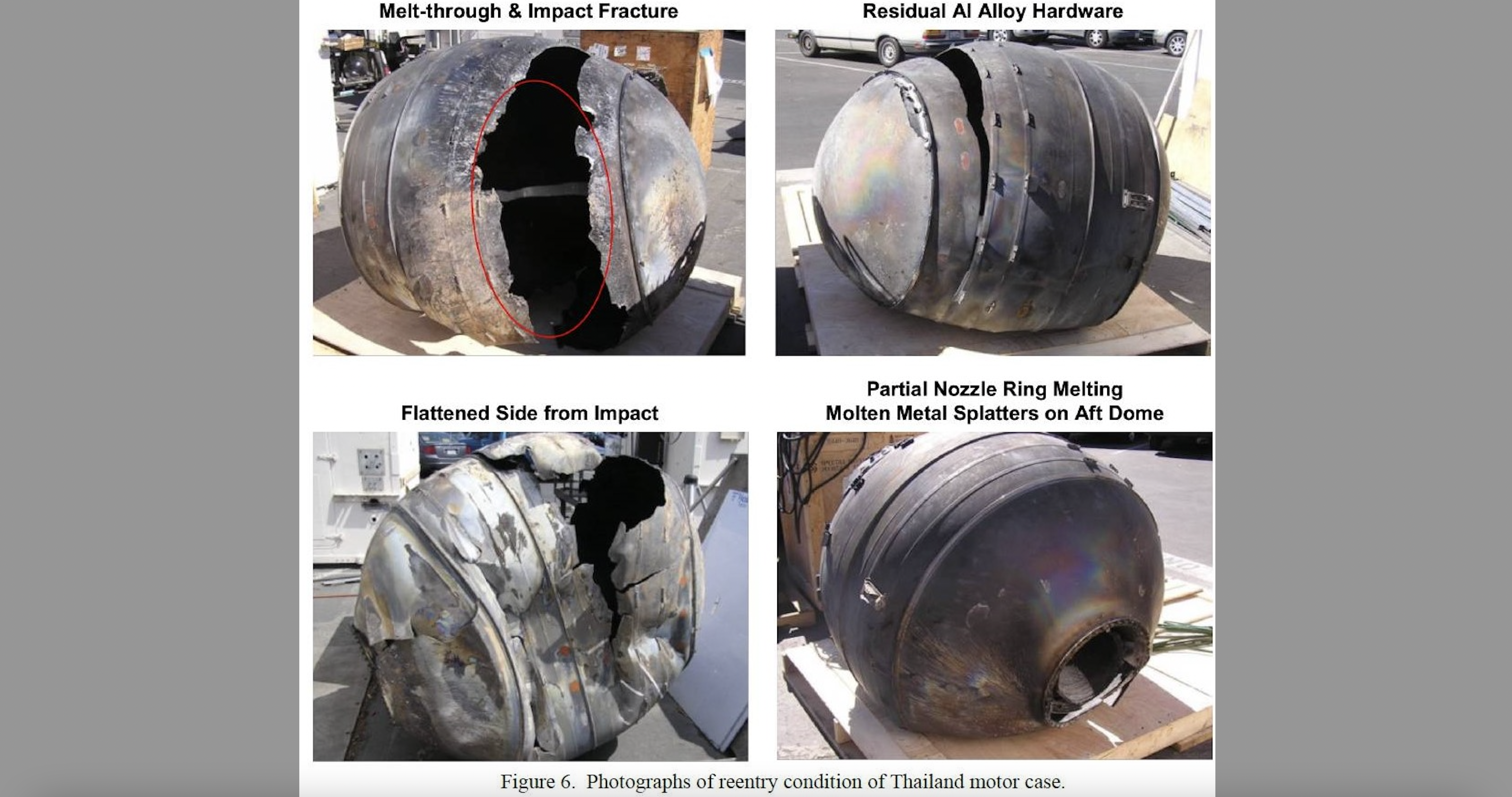People are finding more and more pieces of downed space junk here on Earth. Over the years, some recovered wreckage from fallen rocket bodies and spacecraft has been hauled to research facilities for intensive scrutiny.
Up-close inspection of this space debris is aiding research into the fiery and destructive reentry process.
For example, scientists are working to advance design alternatives that would cause incoming space hardware to disintegrate more fully during its plummet through Earth’s atmosphere — “design for demise” in the parlance of the field.
Related: Getting space junk under control may require an attitude shift
Puzzle pieces
“When you get those chunks back, there’s definitely some interesting information,” said Marlon Sorge, a technical fellow for the Space Innovation Directorate of The Aerospace Corporation and executive director of the nonprofit organization’s Center for Orbital and Reentry Debris Studies (CORDS).
“Trying to understand the reentry process is very much like trying to piece together puzzle pieces, but you don’t have most of the puzzle pieces,” Sorge told Space.com. The ongoing work could help researchers better understand the conditions that incoming hardware experiences on its blistering plunge through Earth’s atmosphere.
Sorge noted that a big plus is the knowledge, in certain cases, of what hardware looked like pre-launch. Adding in where the debris fell allows researchers to reconstruct what happened in the trajectory of hardware falling from orbit.
Surviving the dive
How can a fragment of space junk survive that dramatic dive? What sorts of things are going on within a chunk of debris as it undergoes high-speed heating en route to Earth?
“There are certainly some clear don’t-do’s in design for demise, like using titanium,” Sorge said. “We’ve got several spherical [titanium] tanks that fell out of space. Other than being a little dirty, they look like somebody just set them on the ground.”
So that message is apparent: Don’t use materials that are going to survive, Sorge added.
Learning from retrieved space garbage is a plus, agreed T.S. Kelso, the webmaster for CelesTrak, an online resource to facilitate understanding of the orbital environment and how to use outer space safely and responsibly.
“It seems certainly worth doing the research to see how what we think might reach the ground actually lines up with what actually does,” Kelso said.
Picking up the pieces of reentered objects could help satellite designers construct rockets and spacecraft “that present less risk to things near or on the Earth’s surface,” said Kelso.
Related: The biggest spacecraft to fall uncontrolled from space

Public awareness
Also adding his voice to the incoming debris diagnosis is Darren McKnight, a senior technical fellow at LeoLabs, a company that has built radars worldwide to provide unique measurements and data products that enhance space safety in low Earth orbit.
McKnight points out that there’s a need for greater public awareness of the growing debris problem.
“What goes up must come down” eventually, McKnight said, “and when it comes down, many times accelerated to reduce orbital collision risk, it poses lethal collision risk to aviation and people on the ground.”
Active debris removal, or ADR, in Earth orbit is vitally needed, McKnight said — but it’s not the right solution for every big piece of debris that’s up there.
“The good news is that the aviation and ground risk is ‘one and done,’ but orbital risk goes on and on. ADR via controlled reentry is more expensive than uncontrolled reentry, so it is critical to know when it is necessary and when it is not,” he said.
Heat flux
Alexandre Looten, a researcher with École Polytechnique Fédérale de Lausanne in Switzerland, has been looking into the orbital debris situation as well.
Looten notes that there are many parameters researchers need to know to fully grasp the conditions that lead to somebody finding space refuse here on Earth. Those parameters include the object’s initial mass, the nature of its insulation protection, its orbital velocity, reentry flight path angle and breakup sequence, among others.
“What is clear from all these cases is that the carbon fiber reinforced plastic (CFRP) wrapping was usually still tightly attached, although the matrix part has been mainly pyrolyzed,” Looten said.
Pyrolysis refers to the decomposition of materials through the application of heat. Only the top carbon fiber layers of incoming space junk tend to suffer delamination and spallation, a process in which fragments of material are ejected from a body due to impact or stress, Looten told Space.com.
“This clearly indicates that most of the incoming heat flux of the destructive reentry is absorbed or deflected by the matrix, and these layer degradation processes act as an ablative heat shield,” Looten said.
“So, after several studies on CFRP thermo-ablative process by plasma wind tunnel test campaigns and more specific material testing, the community has identified the key behaviors and major material parameters that affect such process,” he added. “These parameters are now used to create and refine specific composite material demise models for reentry casualty risk assessment.”
Looten is looking into maximizing “composite structure termination” — selecting specific material combinations that should allow a complete and rapid separation and demise of a spacecraft’s external panel upon reentry.

Call to action
Meanwhile, an international open letter has called upon leading space agencies to reduce risks from uncontrolled reentries of rocket bodies and other space objects.
Late last year, the Outer Space Institute (OSI) published a call to action for “multilateral negotiations on a controlled reentry agreement.” OSI is based at the University of British Columbia in Vancouver.
“The uncontrolled reentry of space objects presents a significant, cumulative, fast-growing risk to human beings around the world. Uncontrolled rocket bodies are of particular concern,” states the letter, which was sent to space agency leaders around the world.
“We call on your agencies, working with your states’ foreign ministries, to initiate multilateral negotiations on a controlled reentry agreement, starting with rocket bodies. Recognizing that such negotiations take time, we further call on each of your states to unilaterally commit to a national controlled reentry regime,” the letter states.
While the letter focuses on the casualty risks from uncontrolled rocket body reentries, it also flags the fact that uncontrolled satellite reentries are a concern “and may eventually dominate the casualty risk should tens of thousands of medium-sized to large satellites be placed into orbit.”
The OSI open letter suggests a reentry regime that first starts with rocket bodies and then expands to satellites to reduce all uncontrolled reentry risks.
“Simply hoping that uncontrolled reentries will not cause harm is an unsustainable strategy. With leadership, cooperation and global goodwill, these preventable and therefore unnecessary dangers can be greatly reduced,” the letter concludes.
Related: SpaceX’s Starlink constellation could swell by 30,000 more satellites
Advanced planning needed
Sorge of the Aerospace Corporation feels that policy development and risk assessment regarding reentering objects are a work in progress.
“We’re working to try and catch up and attempting to get a handle on ‘What does this all mean?’ and ‘What do we need to be doing so that we don’t make things worse?'” Sorge said.
From Sorge’s viewpoint, it is critical that the space community think about debris ahead of time.
“We had a little bit of grace in the old days because there wasn’t as much traffic. But we’re getting to the point now where that’s not necessarily true,” Sorge said. “We need to be thinking about the debris consequences beforehand, not as an afterthought.”
Leonard David is author of the book “Moon Rush: The New Space Race (opens in new tab),” published by National Geographic in May 2019. A longtime writer for Space.com, David has been reporting on the space industry for more than five decades. Follow us @Spacedotcom (opens in new tab), or on Facebook (opens in new tab) and Instagram (opens in new tab).

